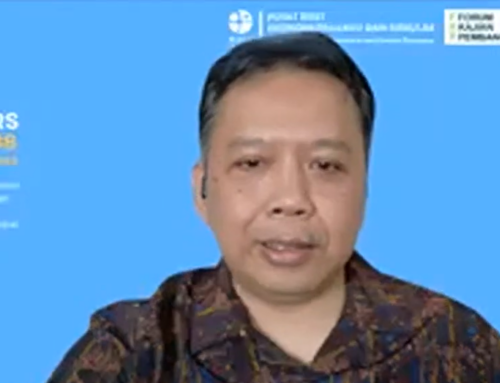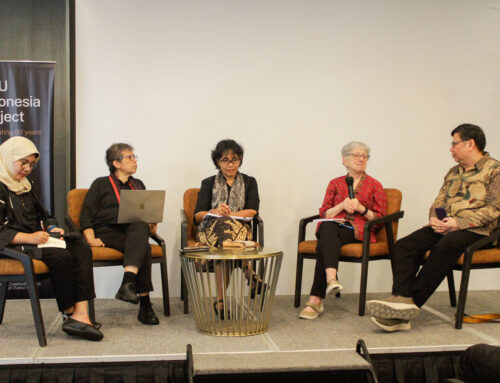FKP hosted by ANU Indonesia Project with Premachandra Athukorala (Emeritus Professor of Economics, Arndt-Corden Department of Economics, Crawford School of Public Policy, The Australian National University). Thursday, 6 May 2021.
KEY POINTS:
- Relative labor cost has been a significant contributor to the growing importance of developing countries in GMVC. However, not all low-wage countries have gained in the process. The relative labor cost alone does not seem to explain differences among developing countries in their success in joining GMVC, as demonstrated by Indonesia and the Philippines which, despite having an abundance of labor at relatively low wages, continue to remain small players in GMVCs.
- What are the other determinants? The first is labor market conditions. At the initial stage, the availability of trainable unskilled labor, and middle-level supervisory and technical manpower are key determinants. The second determinant is the reduction in service link cost which is the costs involved in coordinating production blocks/tasks located across borders. The third one is FDI promotion, it is not necessary to wait until all the desirable elements of the investment climate and human capital requirements are achieved to launch an investment promotion campaign. What is required is a promising and credible start on those fronts, with a firm commitment from the top political level.
SUMMARY
- Over the past half a century, the source country composition of manufacturing exports has shifted away from developed countries and towards developing countries. This structural shift in world trade has been underpinned by the shifting of production from developed to developing countries through global production sharing. Global production sharing opens up opportunities for countries to specialize in different slices of the production process in line with their relative cost advantage. In a labor-abundant economy, assembly activities within global production networks tend to be relatively more labor-intensive compared to conventional manufacturing (production from start to finish in just one country).
- Successful integration of the manufacturing sector into production networks has played a key role in job creation and poverty reduction in China and other high-performing East Asian countries. It opens up greater opportunities for achieving economies of scale and scope. When production is fully produced in a single location, achieving scale economies is limited by the volume at the end-product level. Production sharing also helps overcome the ‘tyranny of distance’ (distance-related trade cost), opening up opportunities to specialize in high-value-to-weight components in the value chain.
- Since the early 2010s, however, there has been a mild slowing down of China’s engagement in the global manufacturing value chain (GMVC). So far, the major beneficiary of the slowdown in the Southeast Asia region has been Vietnam, while Malaysia and Thailand do not have a relative labor cost advantage compared to Vietnam. Indonesia and the Philippines (also India) have continued to remain small players in GMVCs. They have an unattractive investment climate, despite the abundance of labor at relatively low wages.
- Relative labor cost has been a significant contributor to the growing importance of developing countries in GMVC. Inter-country wage differentials have played an important role in spreading GMVCs from first comers to latecomers in East Asia. However, not all low-wage countries have gained in the process. The relative labor cost alone does not seem to explain differences among developing countries in their success in joining GMVC. What are the other determinants?
- The first determinant is labor market conditions. At the initial stage, the availability of trainable unskilled labor, and middle-level supervisory and technical manpower are key determinants. In the long run, the availability of high-level technical and managerial manpower is vital for moving into high-value creating segments in the smile curve. Labour market flexibility is important and the size of the domestic labor pool matters.
- The second determinant is the service link cost which is the costs involved in coordinating production blocks/tasks located across borders. Service link cost in a given country depends on a whole range of factors impacting the overall business environment: Liberal trade and investment policy regimes, trade-related infrastructure and logistics, institutions such as property rights protection and enforcement of contracts, political stability, and policy certainty.
- The third one is FDI promotion. The growth of global production sharing makes a strong case for concurrent liberalization of trade and FDI policy regimes. FDI and trade policies are co-determinants of the location choice of multinational enterprises within production networks. It is not necessary to wait until all the desirable elements of the investment climate and human capital requirements are achieved to launch an investment promotion campaign. What is required is a promising and credible start on those fronts, with a firm commitment from the top political level. Winning an ‘investment tournament’ by a new host country requires commitment at the highest political level.
- With the rapid expansion of global production sharing, the conventional approach to trade flow analysis, which attributes the commercial value of a product to the last country of origin, is becoming increasingly misleading. This phenomenon calls for a change in the analytical and statistical tools we use to measure and understand the real world. The expansion of global production sharing has made inputs and capital increasingly mobile across national boundaries and hence the patterns of production and trade have become more sensitive to the overall investment climate of the country. It is important to promote a wider shared understanding of the phenomenon of global production sharing in business and policy communities.





